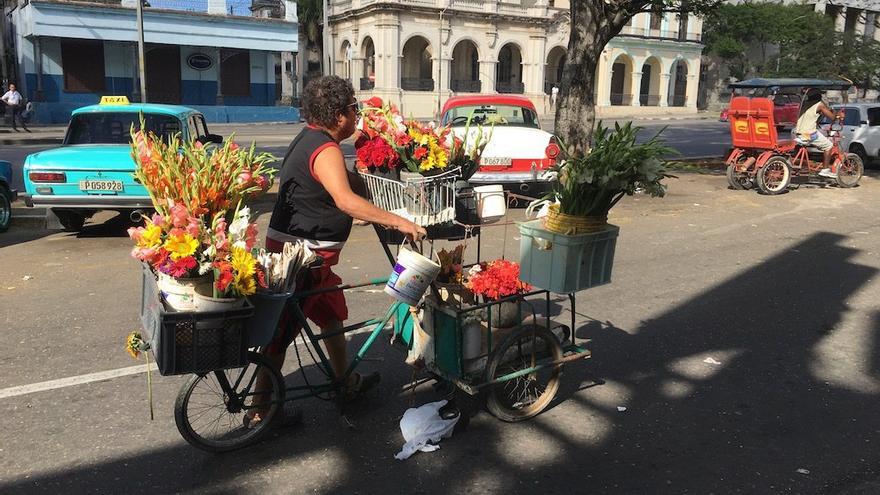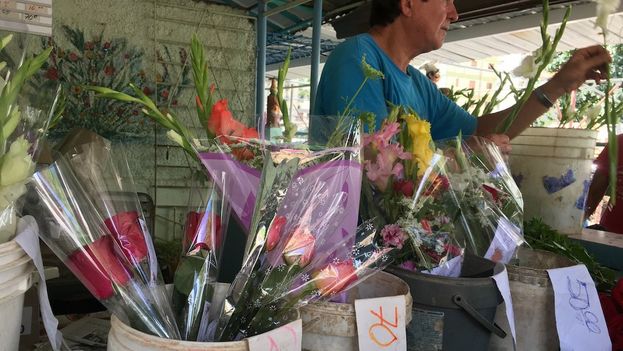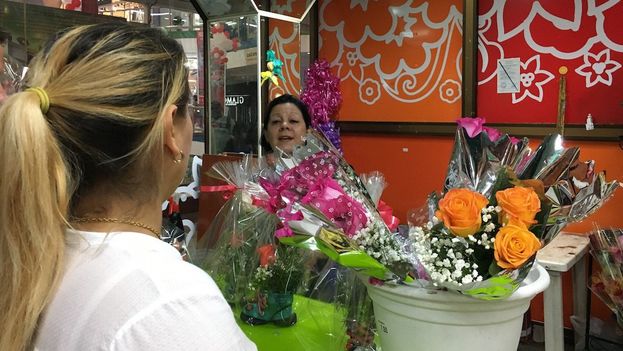
![]() 14ymedio, Zunilda Mata, Havana, 14 February 2018 — In Hoyo de Monterrey, the place where the best tobacco from Cuba is sown, a silent battle has been going on for years. The tobacco growers of the area, forced to sell their leaves to the state companies, opt increasingly for the cultivation of flowers, a production that they can manage with greater autonomy and benefits since they can avoiding trading with the state company Acopio and instead sell independently.
14ymedio, Zunilda Mata, Havana, 14 February 2018 — In Hoyo de Monterrey, the place where the best tobacco from Cuba is sown, a silent battle has been going on for years. The tobacco growers of the area, forced to sell their leaves to the state companies, opt increasingly for the cultivation of flowers, a production that they can manage with greater autonomy and benefits since they can avoiding trading with the state company Acopio and instead sell independently.
The breeze tickles the roses of the Pérez brothers’ farm in the municipality of San Juan y Martínez in Pinar del Rio. Among the bushes, several members of the large family are moving with great care through the rosebuds, which must be ready to leave the field on the eve of February 14.
On Valentine’s Day, known on the Island as Lovers’ Day, there is a frantic purchase of flowers, chocolates and stuffed animals and a making of restaurant reservations. With the expansion of the private sector, the gifts available for the day have expanded, but roses continue to be first among the preferences.
“This crop has its peak moments and the skill is to take advantage of them,” says Juan Pablo, one of the producers who for years had dedicated himself to the cultivation of tobacco and vegetables, but who has also, little by little, started to plant flowers. Mother’s Day and the day dedicated to teachers, on December 22, are other times of great demand.
“We basically plant roses and, within them, the variety known as Black Prince, because they are the ones that people buy the most,” the farmer points out. “In this area there are also those who make their own crosses and grafts, but we prefer to go with the sure thing.”
The flower trade is a fight against time. The degradation of the product once it leaves the furrows is accelerated due to the lack of suitable containers and preservatives. “Our flowers have a lot of aroma but deteriorate very quickly,” adds Carmelo, another Herradura producer at Consolación del Sur.
Between 1955 and 1960 Cuba exported flowers to the southern United States but the drop in rose production in Cuba has forced the import of the flower from Ecuador and Colombia to satisfy domestic demand, especially in the tourist centers, according to data contributed by Manuel García Caneiro, a specialist in nature protection and conservation.
For Garcia Caneiro, the revival of the the sector urgently requires more technology, the introduction of more clones “of the species that are suitable for the conditions here, and prioritizing tropical flowers that are stronger and more in tune with the new trends in taste.”

The final destinations of the private flower production from the area of Pinar del Río and Artemisa are the closest cities, especially Havana. “They have to get out of here the day before so they can make the trip in the afternoon or at night and be with the flower sellers by first thing in the morning,” says Carmelo.
The producer’s son has a “spider,” the two-wheeled cart pulled by a horse typical of the Cuban fields. “We put them in the spider separated in buckets of water and covered with a thin damp cloth so that the wind does not hurt them and they stay fresh,” says Carmelo.
In his fields, papayas, malangas, tobacco and cucumbers are losing the battle for space. “Now we plant mainly flowers because it is a better business and we have sellers that we supply directly,” says the grower.
“I have roses, gladioli, Chinese carnations, lilies and jasmine.” The latter is the island’s national flower and has an intense perfume, but in the farmer’s opinion “it takes a lot of work, because it is a plant that needs a lot of moisture and its petals are very fragile.”
Herradura has become the nursery of flowers this part of the country. The reasons that have led farmers to prefer this crop range from economic issues to autonomy when marketing the final product.
“I had tobacco and even potatoes but it was all a big mess afterwards to sell the harvest to the State and I suffered a lot from their failure to pay,” says Carmelo. “Since I’ve been working with flowers, it’s money in the hand every time I do business.” This farmer also sells rose bushes planted in polyethylene bags for gardens.
With the cultivation and sale of flowers, the producer can avoid dealing with Acopio, the state company that serves as an intermediary between farmers and consumers in the case of many products. “With this I swim or sink on my own, if a harvest fails it’s my problem but if I sell it well then it’s my benefit.”
He adds, “The farmers of this area who have managed, in addition to selling the flowers, to sell the plant are the ones who are earning the most.” On Valentine’s Day Carmelo can get up to 3,000 Cuban pesos (~$120 US) in sales to distributors, but “from that you have to subtract what you invested, which is a lot.”
The initial expense, just in seeds, amounts to 2,000 CUP, but with the adult plants you can divide them, in addition to grafting. The water pump cost 6,000 CUP and opening another well about 1,000 CUP. In addition, he has planting beds for the varieties with smaller plants and has had to invest in clay tiles for around 700 CUP.
“The flowers are very demanding in terms of water supply, so I had to invest a lot in irrigation and pumps,” says the farmer. “There has to be fertilizer and the largest proportion must be organic matter so I have even had to turn my hand to making it with farm waste”.
“Earthworm castings is the best thing to keep plants healthy and many times I have to buy it from the State or from other farmers in the area who make it to sell.”

Carmelo’s son hits the horse with the whip and the spider begins its way to Candelaria while afternoon falls. From there all the flowers will leave for the capital in a truck loaded with the merchandise of several producers. They have to arrive before the first rays of Valentine Day begin to illuminate the city.
At dawn in Havana, Rogelio, a mechanic who exchanged his tools for petals, takes out the tricycle that he keeps in the parking lot of a Vedado building. On the sidewalk he organizes the water containers filled with the flowers that have just arrived. The aroma floods the entire area.
The vendor distributes sunflowers, gladioli, roses, carnations, jasmines and Chinese daisies by the dozens.
“I bought double what I buy on normal days and the one that sells the most is the black prince, they buy it by the dozens, that’s why the song of twelve roses …,” he says, while humming a catchy ballad popularized on the Island by the Mexican singer Lorenzo Antonio.
“I’ve been doing the same thing for 15 years,” says Rogelio, who has his fixed sales points. His hopes are that, one day, he will be able to stop having to sell on the street and instead will supply shops or hotels in the capital. “But that doesn’t happen because those places still prefer foreign flowers,” he laments.
The markets, stores and shops that sell in hard currency are full of impeccable and stylized roses that can cost up to 5 Cuban convertible pesos each (about $5 US), the salary of a week. “People think that imported flowers are prettier but they do not smell like anything.”
Along with the sale, Rogelio offers his clients recommendations. “Carry the bouquet in your hand upside down and just put it in the vase with an aspirin in the water to make it last,” he tells a client who pays for three dozen black princes at a price that would be only enough for four flowers in the markets in convertible pesos.
“We offer a much cheaper, domestic and fragrant merchandise, even the bees come here to surround the flowers, but with those that are sold in hard currency, nothing of that happens,” Rogelio says, promoting his product.
Other entrepreneurs have taken the business of selling flowers further, such as a small store near Avenida de los Presidentes, where they prepare bouquets with decorations ready to give as a gift. This Tuesday the employee could not cope. “There are people who like to give the bouquet early and they buy it today so they can give it to someone as soon as it’s light.”
The shop has prices higher than those of the street vendors but still economical compared to the state shops. For less than 2 CUC a customer takes a bouquet of daisies mixed with wildflowers and a beautiful addition of greenery.

In spite of the prices, customers also crowd into the centrally located state flower shop in the Plaza de Carlos III. “I don’t care that they don’t smell, but they last longer and I want to make my wife a gift that she can enjoy for several days,” a man who has chosen a dozen white roses justifies himself.
Something similar is believed by the employees of the Hotel Plaza, very close to Central Park, where they have adorned the entrance of the neoclassical accommodation with a huge bouquet of imported roses. “Even at Fidel Castro’s funeral the flowers came from outside,” says a Cuban guest who lives abroad and has been eyeing the flowers.
A few yards away, an exclusive flower shop offers the buds brought from Ecuador and some tourists ask a street vendor where they can buy “typical Cuban orchids for a gift,” but the man has only black prince roses.
________________________
The 14ymedio team is committed to serious journalism that reflects the reality of deep Cuba. Thank you for joining us on this long road. We invite you to continue supporting us, but this time by becoming a member of 14ymedio. Together we can continue to transform journalism in Cuba.
